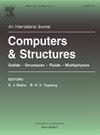Prediction of nonlinear dynamic responses and generation of seismic fragility curves for steel moment frames using boosting machine learning techniques
IF 4.4
2区 工程技术
Q1 COMPUTER SCIENCE, INTERDISCIPLINARY APPLICATIONS
引用次数: 0
Abstract
The main objective of this paper is to develop machine learning (ML) models for predicting the seismic responses of steel moment frames. For this purpose, four boosting ML techniques-gradient boosting, XGBoost, LightGBM, and CatBoost-were developed in Python. To create an inclusive dataset, 92,400 nonlinear time-history analyses were performed on 1,848 steel moment frames under 50 earthquakes using OpenSeesPy. Geometric configurations, structural properties, and ground motion intensity measures were considered as the inputs for the models. The outputs included maximum global drift ratio (MGDR), maximum interstory drift ratio (MIDR), base shear coefficient (BSC), and maximum floor acceleration (MFA). The study also investigated the effectiveness of the ML models in estimating fragility curves for an 8-story steel frame at different performance levels. Finally, a web application was developed to facilitate the estimation of the peak dynamic responses for steel moment frames. The results show that the LightGBM and CatBoost models demonstrate superior predictive performance, with coefficient of determinations (R利用提升机器学习技术预测钢弯矩框架的非线性动态响应并生成地震脆性曲线
本文的主要目的是开发用于预测钢矩形框架地震响应的机器学习(ML)模型。为此,使用 Python 开发了四种增强 ML 技术--梯度增强、XGBoost、LightGBM 和 CatBoost。为了创建一个包容性数据集,我们使用 OpenSeesPy 对 50 次地震中的 1848 个钢弯矩框架进行了 92400 次非线性时史分析。几何配置、结构属性和地动强度测量值被视为模型的输入。输出结果包括最大总体漂移比 (MGDR)、最大层间漂移比 (MIDR)、基底剪切系数 (BSC) 和最大楼层加速度 (MFA)。研究还调查了 ML 模型在估算不同性能等级的 8 层钢结构框架脆性曲线时的有效性。最后,还开发了一个网络应用程序,以方便估算钢矩形框架的峰值动态响应。结果表明,LightGBM 和 CatBoost 模型的预测性能优越,确定系数 (R2) 高于 0.925。此外,LightGBM 模型能以最小的误差估算脆性曲线(例如,预测曲线中值的相对误差小于 10%)。
本文章由计算机程序翻译,如有差异,请以英文原文为准。
求助全文
约1分钟内获得全文
求助全文
来源期刊

Computers & Structures
工程技术-工程:土木
CiteScore
8.80
自引率
6.40%
发文量
122
审稿时长
33 days
期刊介绍:
Computers & Structures publishes advances in the development and use of computational methods for the solution of problems in engineering and the sciences. The range of appropriate contributions is wide, and includes papers on establishing appropriate mathematical models and their numerical solution in all areas of mechanics. The journal also includes articles that present a substantial review of a field in the topics of the journal.
 求助内容:
求助内容: 应助结果提醒方式:
应助结果提醒方式:


